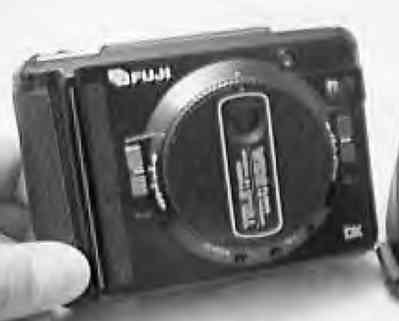
Fuji TW3
The mid 1980s saw a resurgence of the half-frame format. Yashica produced
the Samurai, Konica the AA-35 and Fuji the TW3 in 1985. It is truly
a modern-day half-frame. It has so many advanced features it's hard
to know which to list as most important. It has two lenses -- a 23mm
(f8.0) and a 69mm (f8.0). So you can select a wide angle (equivalent
to a 33mm full-frame image) or telephoto shot (equivalent to a 100mm full-frame
image). That's why it's called the TW3. It stands for Tele-Wide
3X. There is no "normal" lens. The lens is selected by rotating
the front of the camera. Each of the lenses has its own focusing scale.
The wide-angle lens focuses to 1.5 feet while the tele lens focuses
to 13 feet. A built-in CDS meter controls the exposure in a programmed
auto-exposure system setting the f-stop and shutter speed automatically.
Shutter speeds run from 1/30 - 1/500, and apertures from f8 - f16.
There are no manual settings of the shutter speed or aperture. Film
speed is controlled through DX coding from ISO 100 to 1600. But that's
not all. The TW3 also has a built-in, pop-up flash, and a motor drive.
The film runs vertically, like in the Konica AA-35, so the camera provides
horizontal pictures as the standard. Think of it as a cross between
the Konica AA-35 and the Olympus Infinity Twin. It has the size and
feel of the Konica and the dual lenses of the Twin. What more could
you want, except maybe a faster lens? The camera lacks a tripod socket,
a cable release connection and a self-timer, but it does have a backlight
button and a TV button so that you won't get lines in the picture. The
motor drive can be used in single or continuous mode. The camera is
obviously designed to be used with ISO 400 speed film in bright conditions,
but it is a take-anywhere type of camera. The built-in A2/3 lithium
battery is large (about the size of your index finder) and designed to last
about five years. At that point, the manual instructs you to take it
to a repair shop. Of course, that will cost as much as a new camera.
Fortunately, you can do it yourself, if you can locate a replacement
battery -- and a soldering iron. On the door of the camera, is a grip
that looks like it might be the motor drive. In fact, it is the battery.
There are two tiny screws that open the battery compartment. There
is no need to remove the covering -- it acts as a hinge. Just unsolder
the old battery and insert a replacement. You're good for another five
years.
COPYRIGHT @ 1995, 1996, 1997, 1998, 1999, 2000, 2001, 2002, 2003, 2004, 2005 by Joe McGloin. All Rights Reserved.

